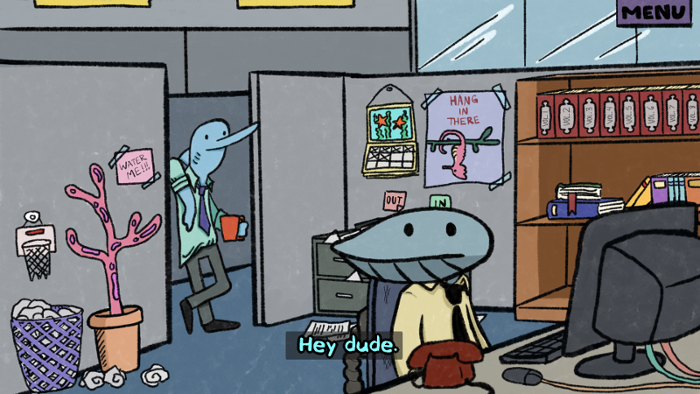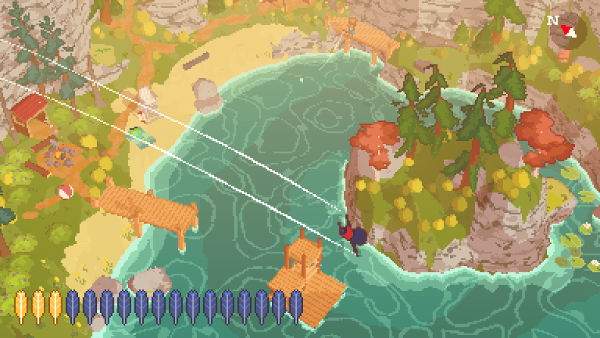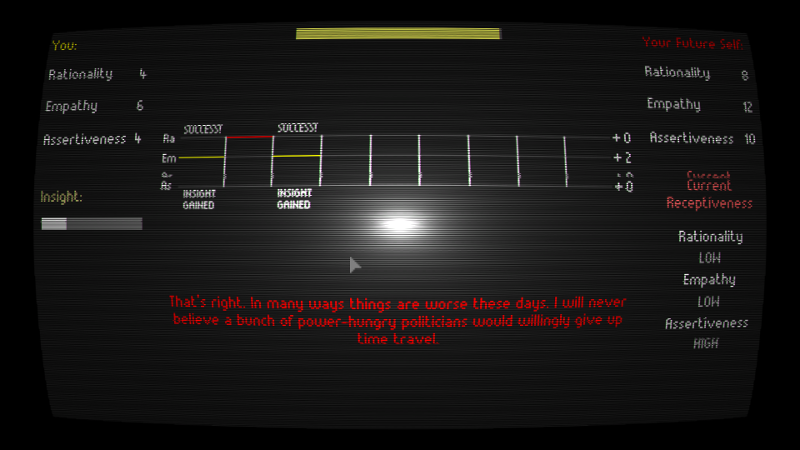Reviews by Eloquence
I’m a big fan of point and click adventures (think The Secret of Monkey Island), a genre that’s frequently been declared dead but that is in fact thriving thanks to crowdfunded major efforts like Broken Age (reviews) and Thimbleweed Park (reviews), smaller studios like Wadjet Eye, and releases by even smaller teams or solo developers. Clam Man is very much the latter, developed by “Team Clam” which appears to comprise three collaborators.
The game is set in a world dominated by anthropomorphic aquatic creatures. You play Clam Man, an ordinary bloke working as a junior sales representative at Snacky Bay Prime Mayonnaise. After Clam Man gets fired for no apparent reason by his crab boss, he begins to uncover a larger mayo-centered conspiracy. Does it go all the way to the top? Mr. Man will try to find out.

Not all is as it seems at Snacky Bay Prime Mayonnaise. (Credit: Team Clam. Fair use.)
It’s all ridiculous, of course, but some of the jokes are quite funny, and the minimalist hand-drawn art is often very charming. This is only a two hour game, the mouse controls are a bit frustrating, and the writing and artwork don’t quite hold up throughout the short playtime, so the current asking price of $10 is a bit high.
If you already own the game from The Mother of All Bundles, or if you can get it for $5 or less, you’re unlikely to regret your visit to Snacky Bay. Team Clam is certainly one indie developer to keep an eye on.
A Short Hike lets you explore the colorful, pixelated world of Hawk Peak Provincial Park in the role of a vacationing anthropomorphic bird named Claire. Your mission, should you choose to accept it, is to make it to the top of Hawk Peak, ostensibly in search of cell phone reception.
As you make your way through the park, you meet a diverse cast of animal characters. Some offer you side quests, others are simply pursuing their own adventures in the park. It’s up to you whether you want to accept any of these quests, but if you want to make it to the peak, you’ll need to at least obtain a few golden feathers, which allow you to climb the distance.
The game doesn’t end after you reach the peak. There are treasures to be found, hats to be purchased, fish to be caught, and co-operative games of beachstickball to be played. And it’s fun to explore. In spite of the intentionally low resolution graphics, when you sky-dive from the top of a hill, A Short Hike manages to convey a real sense of velocity and freedom.

You can fly, dive, swim, climb, walk, and run. (Credit: Adam Robinson-Yu. Fair use.)
You can’t die in this world, or screw up in any irreversible way. Nor does the game offer the endless grind of more complex farming, fishing, and crafting games. You can rush through the game, or spend a few hours with it, but after that, you’ll likely be done with it—at least until you feel like paying another visit to the park.
If you’re looking for a game to challenge your reflexes or your logic, this ain’t it. But if you just want to chill in a beautiful setting, it’s a perfect pick-me-up.
In Some Assembly Required, biologist Neil Shubin explores a theme he already touched upon in his 2008 book Your Inner Fish and the 2014 PBS documentary of the same name: How do complex bodies, with all their specialized functions, evolve? How does evolution build on that which has come before?
To answer these questions, Shubin revisits the discoveries of biologists and naturalists of the past and introduces some of the most recent findings of molecular biology. This is a popular science book, so scientific facts become stories whose protagonists are brought to life with biographical detail.
The key concepts Shubin introduces include:
-
how biological traits that have evolved for one function are re-purposed (exapted) for another (e.g., feathers likely evolved first for temperature regulation, then were exapted for flight);
-
how small changes in embryonic development can have dramatic effects on the resulting individual—e.g., the slowing of physiological development known as neoteny, where adults may retain traits otherwise only seen in the young;
-
how gene duplication events (e.g., via self-copying genes known as transposons or “jumping genes”) enable evolution to experiment with myriad small variations of existing genetic recipes, which has led to vast gene and protein families;
-
how plant and animal cells incorporated previously free-living organisms and thereby gained crucial new capabilities, the classic examples being mitochondria (the powerhouses of animal cells) and chloroplasts (the photosynthesis engines of plant cells);
-
how viral elements have made their way into our DNA and have been co-opted for important biological functions (e.g., to make the protein syncytin, which is a key component of the placental barrier between fetus and mother).
Shubin explains how evolution often arrives at the same solution multiple times, with different genetic origins, and illuminates why some evolutionary pathways are likelier than others.

A retrovirus upon integration in the host genome (A), where its genetic code has been co-opted for building a protein used in placental development (B, top), and for the regulation of birth timing (B, bottom). (Credit: PLOS Biology / Edward B. Chuong. License: CC-BY.)
The book only scratches the surface of these concepts, and much of what it does cover is likely to be well-trodden ground for readers who have picked up a book about evolutionary biology since their school days. At the end of each chapter, I found myself hungry for more detail.
To Shubin’s credit, in the final section of the book, he provides a kind of afterword for each chapter, which includes sources and additional reading recommendations. I found this approach much more useful than a conventional bibliography or a set of disjointed footnotes.
I would give this book 4 stars — it’s a light, quick and engaging read on a fascinating topic. For readers looking for more breadth or more depth, I would recommend the following writers:
-
Richard Dawkins, if you are not put off by his politics, is still one of the best science writers I know. The Greatest Show on Earth: The Evidence for Evolution (2009; reviews) is a passionate, detailed and eloquent introduction to evolutionary biology.
-
Nessa Carey has a remarkable talent for getting as close to the science as possible while still writing for a lay audience. I read The Epigenetics Revolution (2012) and was deeply impressed by her clarity and ability to break down very complex concepts.
-
Andreas Wagner is a biologist bringing his own ideas to a larger audience through popular science writing. If the science behind it withstands scrutiny, Arrival of the Fittest (2014; reviews) could well be turned into a new chapter in the next edition of Some Assembly Required.
In short, Wagner argues that in order to find new functions for old genes, evolution has to take a “genetic walk” from A (old function) to B (new function). He explains the importance of neutral mutations in these genetic walks. His latest book, Life Finds a Way: What Evolution Teaches Us About Creativity, looks similarly fascinating.
If you’re on the fence about Some Assembly Required, consider getting a copy of the PBS documentary Your Inner Fish. It showcases Shubin’s storytelling talent while still packing a good amount of science. If you enjoy it, you’re unlikely to be disappointed by Some Assembly Required.
A Normal Lost Phone (reviews) by Accidental Queens allowed the player to explore a simulated smartphone to discover what happened to its owner, an 18-year-old named Sam. Another Lost Phone uses the same idea to explore different themes. This time, the phone in question belongs to a woman named Laura, who has apparently gone missing.
SMS messages reveal that her boyfriend, Ben, is deeply concerned about her disappearance—but some of his earlier messages suggest a controlling personality, hinting at another story to be uncovered.
The story is told through messages, photos, emails, calendar entries, and notes, many of which are only accessible until you’ve figured out a password or PIN number through various clues. Most of these puzzles are pretty easy, but if you find yourself getting stuck, the excellent Steam Guide will help you to advance without any spoilers.

The first messages we see are from Laura’s boyfriend Ben, expressing deep concern about her disappearance. (Credit: Accidental Queens. Fair use.)
Like the first game, Another Lost Phone explores sensitive social topics with appropriate care, if you can get past the inherently voyeuristic storytelling device of exploring a stranger’s phone.
The game feels a bit more polished than A Normal Lost Phone, with a more engaging story, where all the different pieces (messages and clues) click together really well. Each game tells its own independent story, and if you’re unsure which one to try first, I recommend this one. My playtime was about 1-2 hours.
I lived in the San Francisco Bay Area from 2008 to 2015. One name that you’ll encounter sooner or later in this region of the United States is Junípero Serra: from Junipero Serra Freeway to Junipero Serra Boulevard, from schools to playgrounds, from hiking trails to the highest mountain peak in Monterey County, and of course the statues—so many statues.
Canonized as a saint in 2015, Serra was an 18th century priest and friar who founded the first Spanish missions in California. Pope Francis claimed that Serra “sought to defend the dignity of the native community, to protect it from those who had mistreated and abused it.” The missions Serra started are popular tourist attractions.
In 2004, Elias Castillo (1939-2020), a journalist and three-time Pulitzer Prize nominee, wrote an op-ed titled “The dark, terrible secret of California’s missions” that described Serra’s work in starkly different terms:
[L]ocked within the missions is a terrible truth—that they were little more than concentration camps where California’s Indians were beaten, whipped, maimed, burned, tortured and virtually exterminated by the friars.
The op-ed was well-received by others familiar with this history, and was read into the Congressional Record. This inspired Castillo to write the book A Cross of Thorns: The Enslavement of California’s Indians by the Spanish Missions (2015).
Castillo documents that Serra was a reactionary even by 18th century standards, a man who believed in witches, rejected Copernicus, practiced extreme self-flagellation, and regarded the natives of California as savages who had to be enslaved to be brought to salvation.

Yokuts hunting near San Francisco Bay as depicted by Russian artist Ludwig Chloris. (Public domain)
Fever dreams of salvation
Natives were herded into the missions and were forcibly returned there if they tried to flee. They lived in conditions of forced labour, and died by the thousands, often from disease which ran rampant due to the high population density. Far from “protecting” the natives, Serra resisted efforts to reduce the rate of death, to provide education or better care.
Instead of education, there was daily mass in Latin, which the natives did not understand. The Church enforced its sexual morality, separated men from women, and punished expressions of intense emotion, including grief. In a 1780 letter to Felipe de Neve, then governor of the Californias, Serra justified the use of flogging:
“That spiritual fathers should punish their sons, the Indians, with blows appears to be as old as the conquest of these kingdoms [the Americas]; so general in fact that the saints do not seem to be any exception to the rule. In the life of Saint Francis Solano … we read that, while he had a special gift from God to soften the ferocity of the most barbarous by the sweetness of his presence and words, nevertheless … when they failed to carry out his orders, he gave directions for his Indians to be whipped.”
Castillo’s book is unsparing but rigorous and well-sourced, often in the words of the people who committed these crimes or witnessed them. The many dedications to Serra in California are honoring a mass murderer. His canonization will forever taint the record of Pope Francis, who is often celebrated as a reformer.
In the wake of calls for racial justice in 2020, this history is becoming more widely known, and the first Serra statues are being removed. The myth of the friendly California missions has no place in the 21st century, and Castillo’s book should help us all to put it to rest.
Additional reading
-
Junípero Serra’s brutal story in spotlight as pope prepares for canonisation
The Guardian, September 23, 2015 -
Junipero Serra was a brutal colonialist. So why did Pope Francis just make him a saint?
Vox, September 24, 2015 -
‘By Their Fruit They Will Be Known’: Junipero Serra as Indian Killer
Indian Country Today, October 14, 2015 -
Sainthood of Junípero Serra Reopens Wounds of Colonialism in California
New York Times, September 29, 2015
Your Future Self is an interactive story developed by Contortionist Games, which as of this writing is one developer, Andrew Hirst, based in Sheffield, UK. The game presents itself in a CRT aesthetic with many flicker effects, similar to Pony Island.
The premise is that you’re stuck in a time looping bubble with your future self and have to convince them not to commit an act that will kill thousands of people, but which your future self clearly considered justifiable. Every dialog choice can succeed or fail. If you ultimately don’t succeed, the loop starts again.
As you pick from different strategies to engage with “yourself”, the story unfolds. You can’t pick the exact words you want to say to yourself—your choices are always to be rational, empathetic, or assertive, and the game decides what that means in a given context.
There’s a light RPG-like mechanic at play here, where your “skill” at being rational, empathetic, or assertive is measured against your future self’s skills and receptivity in those areas. If you turned on “helper mode” on the start screen, the game shows you the likelihood that a given choice will succeed.

The success or failure of your attempts to persuade your future self is visualized, and is subject to a simple RPG-like mechanic. The CRT scanline effect, curved screen, and center glare are in-game visuals. (Credit: Contortionist Games. Fair use.)
There are, of course, additional layers to the story, and the game employs intense visual effects to keep things interesting. It also has an excellent chiptune soundtrack. Check out Rebels to the Rescue and Your Future Self (Remix).
The time loop mechanic can get a bit tedious if you have to click through the same loop a couple of times to find the right answers—in retrospect I think I would have enjoyed the game more if I had enabled “Helper mode”. The story was interesting enough to keep me engaged until the ending (I think I played for about 1-2 hours).
I’d give it 4 stars—the game mechanics and story aren’t perfect, but the excellent soundtrack and atmosphere make up for most of the game’s weaknesses.
The liberal Western narrative of the Cold War is that a flawed but well intentioned democracy (the United States) prevailed against a tyrannical regime that sought to spread its ideology throughout the world (the Soviet Union). The rest of the world is assigned bit parts in tales of proxy wars and covert ops between the superpowers.
In The Jakarta Method, journalist Vincent Bevins reveals a much darker story of the Cold War, one in which Third World nations sought independence from colonial rule and from post-colonial imperial domination by any superpower, and in which the United States and its allies countered such efforts, in part, through an international program of mass murder.
As the book’s title suggests, this history is centered on events in Indonesia, which is the 4th most populous nation on Earth today. After achieving its independence from the Dutch (whose colonial rule had left the country with a literacy rate of less than 10%), the new country’s first president, Sukarno, sought to build alliances with other Third World nations and organized the historic Bandung Conference in 1955.
A template for mass murder
Sukarno was not a communist, but he tolerated the Communist Party as one of multiple constituencies he unified under his increasingly authoritarian rule. The United States grew impatient with Sukarno’s anti-imperialism, and supported staunchly anti-communist military men who could replace him.
Eventually, one such man, Suharto, used the chaos of a failed coup attempt by other members of the military (of which he had foreknowledge) as a pretext to take power. He blamed the communists and implemented a mass murder program that killed a vast number of human beings, with estimates ranging from 500,000 victims on the low end to 2-3 million on the high end.

Alleged young communists detained by Indonesian troops in October 1965. (Credit: Associated Press. Fair use.)
The US did not simply tolerate this campaign; it provided training and support to anti-communists in the Indonesian military, and even supplied kill lists which were used to hunt down and murder thousands, as the Washington Post reported in 1990:
For the first time, the officials are acknowledging that they systematically compiled comprehensive lists of communist operatives, from the top echelons down to village cadres in Indonesia, the world’s fifth most populous nation. As many as 5,000 names were furnished over a period of months to the army there, and the Americans later checked off the names of those who had been killed or captured, according to the former U.S. officials.
Unlike other atrocities of the 20th century, this one remains little-known in the Western world, for obvious reasons: history is written by those who prevailed. As Bevins shows, the slaughter became a template for mass murder programs elsewhere, including in Latin America.
Before those programs began under authoritarian regimes in countries like Chile, Argentina, and Brazil, the word “Jakarta” itself was employed as a threat. Leftists and fanatical anti-communists alike knew all too well what it meant: mass murder at an unimaginable scale. Suharto had made Indonesia’s capital synonymous not with Third World emancipation, but with exterminating the political left.
Making the world safe for capitalism
The narrative of anti-communism is that all movements calling themselves socialist or communist ultimately become tyrannical, justifying the absolutist stance that the United States took in the Cold War. But the US supported murderous regimes like Suharto’s, while forcefully opposing emancipatory politics by Third World countries—no matter how democratic.
By replicating the Jakarta method around the world, the US and its allies destroyed the possibility of a moderate, democratic path to political and economic emancipation for Third World countries. The “friendly dictators” installed to exterminate the left frequently brought ruin for the rest of society, as well. Besides slaughtering hundreds of thousands, if not millions, of his own people, Indonesia’s Suharto embezzled up to $35 billion; in 2004, Transparency International ranked him as the world’s most self-enriching leader of the previous two decades.
The Jakarta Method is not a defense of communism as it existed in the 20th century. Bevins promotes no ideology and refrains from hyperbole or polemic; he simply recounts the facts, supported by the personal stories of survivors from around the world. If anything, given the secrecy of the programs Bevins writes about, many chapters in this dark history likely are yet to be illuminated.
The book reveals that the Cold War cannot be understood without the stories of the millions of people who fought for a better tomorrow, and whose lives were brutally extinguished to bequeath us the world we live in today. Not because of a choice between a greater and a lesser evil, as the liberal Cold War narrative would have us believe, but because of actions which were unspeakably evil in their own right.

You get to browse websites, read IMs and emails and explore apps, all of which reveal layers of the game’s story. (Credit: Accidental Queens / Dear Villagers. Fair use.) Many games incorporate phones you can interact with into the game; in A Normal Lost Phone, the phone is the game. With little introduction, you get to snoop around the apps and messages stored in a lost phone that supposedly belongs to a kid named Sam who just celebrated their 18th birthday.
You discover who Sam appears to be to their friends and family; as you peel away layers of clues (“which number is the password to this app?”), you also discover new layers to Sam’s story. The story is engaging and handles mature themes of tolerance and identity well, but it is a bit predictable. It’s a short game (1-3 hours, depending on how much time you spend reading every bit of flavor text).
There’s some great artwork to discover, and a nice soundtrack that’s accessible through the phone’s music player.
It’s hard to categorize A Normal Lost Phone, but if you enjoy story-based games like Gone Home that progress quickly with very light puzzles, there’s a good chance you’ll enjoy this one, too. 3.5 stars, rated up because of the high quality art and music and the smooth interface.
Daedalic Entertainment made its name with games like Anna’s Quest and the Deponia series, which are helping to keep the genre of 2D point and click adventures alive. Since then, other developers (e.g., Dontnod with the Life is Strange franchise) have shown that it is possible to translate the exploratory appeal and rich narratives of the genre into beautiful 3D worlds.
State of Mind (2018) is one of Daedalic’s entrants into the 3D adventure genre. Set in the year 2048, it’s primarily told from the perspective of two individuals—Richard Nolan and Adam Newman—who grapple with the trauma of a recent accident, and who find that their lives are deeply connected.
The story that unfolds explores transhumanist themes like strong AI and mind uploading, but it remains grounded in a narrative about Richard Nolan’s relationship with Adam, with his own family, and with a lover.

Protagonist Richard Nolan and his household robot Simon in Richard’s Berlin apartment (Credit: Daedalic Entertainment. Fair use.)
In many parts of the game, the player explores their surroundings (e.g., Richard’s and Adam’s respective futuristic apartments; the gritty Berlin neighborhood where Richard lives, etc.), with limited choices and trivial puzzles. Occasionally, the game throws in a trickier puzzle or a mini-game.
In one of those mini-games, for example, you must navigate a drone through a building’s maintenance shafts in order to listen in on a conversation that happens in another room, without being detected by other drones. If you fail, you get to retry until you succeed.
While State of Mind offers some choices in dialogs, they are fairly inconsequential until the final stage of the game. Then, the player is given a choice between different endings, but even the impact of those choices on the final scenes of the game is a bit underwhelming.
What makes the game work, in part, is that it’s gorgeous. The low poly design of the game’s characters takes some getting used to, but the world they inhabit is rich in detail and imagination.
In one memorable scene, Adam Newman meets his wife on the location of an Augmented Reality art installation, where the game lets you draw with light and sound in the world around you. This scene is just there, and it’s up to the player whether they choose to explore it for its own sake or not.
The Verdict
The story of State of Mind is engaging but derivative, and the execution quality of the game as a whole is mixed (e.g., limited choices, mini-games that can be a bit tedious). Parts of its world are a joy to explore, and the game offers about 10-20 hours worth of generally rewarding play. The native Linux version worked beautifully for me.
I appreciated the game’s willingness to tackle adult themes, the lack of moral finger-wagging, and the deep flaws of its main characters. I found the voice acting not as stellar as, say, Life is Strange, but Doug Cockle (who voices Geralt von Rivia in the Witcher games) pulls you in as Richard Nolan, even if you end up hating him.
While the game is only 2 years old, you’ll now find it on sale regularly for 5 USD or less. At that price, you won’t have any regrets about paying a visit to its morally ambiguous world and the flawed beings that inhabit it.
If It Bleeds by Stephen King advertises itself as containing “four new novellas”, but I would really characterize it as one novella supported by three stories.
The heart of the book is “If It Bleeds” itself, which stars Holly Gibney, an important character from several of King’s most recent books (Mr. Mercedes, Finders Keepers, End of Watch, and The Outsider). After the events of The Outsider, Holly Gibney faces an evil force of a similar nature—but this time, she tries to go it alone. It’s an engaging tale that never overstays its welcome, but I would recommend reading The Outsider first (reviews).
The other stories in the book would make good Twilight Zone episodes. The first one, “Mr. Harrigan’s Phone”, would fit better in Jordan Peele’s reboot than in Rod Serling’s original. It’s about a boy’s friendship with a wealthy old man, a friendship that ultimately takes on a supernatural character. King uses the story to offer his own social commentary on the effects of smartphones, disguised in the words of a cynical old man. Overall I found it the weakest story in the volume.
The second story, “The Life of Chuck”, is told in three acts (ordered in reverse) and describes the impact of a seemingly ordinary man named Charles Krantz on the world around him—starting at a time when the whole world seems to be ending in a series of apocalyptic catastrophes.
The third story, “Rat”, is about a writer who has been struggling for his whole life to finish a novel. When inspiration strikes, he seeks out the isolation of a “basic no-frills cabin in the Maine woods” he inherited from his father, to focus on the novel without the distractions of family and social demands. Soon the isolation, coupled with an illness, starts to play tricks on his mind—or does it?
King’s constant readers can’t go wrong with If It Bleeds; those new to his work looking for recent horror novellas that pack a punch should consider picking up King’s Full Dark, No Stars (2010) instead.
